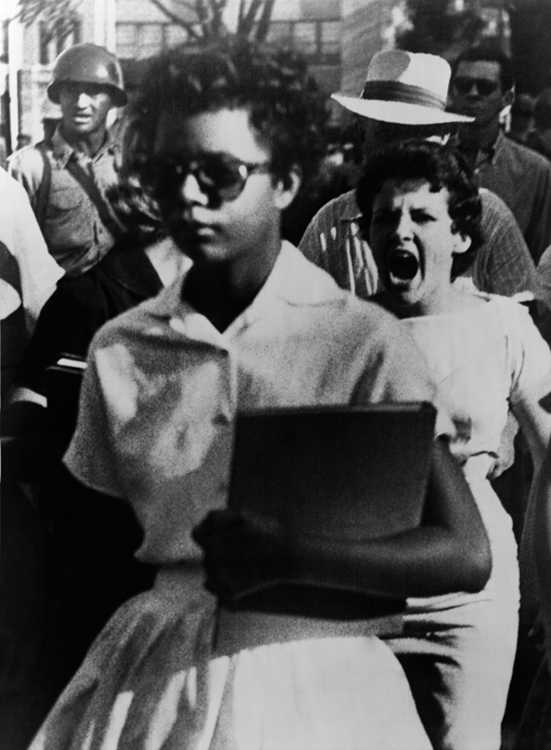Yesterday, September 25, marked the 60th anniversary of the integration of Central High School in Little Rock, Arkansas. On Sept. 25, 1957, nine African American students—remembered as the Little Rock Nine—were escorted into the previously all-white school by United States Army troops. Three years earlier, in 1954, the Supreme Court of the United States had ordered states with segregated schools to open them to all races. Many Southern communities, however, including Little Rock, acted slowly in desegregating their public schools. Central High School’s integration came after numerous legal challenges, heated racial tensions, and the open defiance of Arkansas Governor Orval Faubus. The Little Rock Nine gained worldwide attention, and the event was a landmark moment of the civil rights movement in the United States.
To mark the event’s 60th anniversary, a special commemoration ceremony took place at Central High, and a new sculpture called United was dedicated on the school’s front lawn. A “Reflections of Progress” symposium was held at the Clinton Presidential Center, and numerous other panel discussions, fundraisers, and religious services also took place.
In the 1954 decision of Brown v. Board of Education of Topeka, the Supreme Court ruled that segregation in public schools was unconstitutional. The next year, the court ordered that public school desegregation be carried out “with all deliberate speed.” The Little Rock School Board adopted a plan to begin integrating Central High School in the fall of 1957.
By August 1957, school authorities had selected 17 black students from a group of about 80 students who had applied to integrate Central High. Of the 17 students selected, 8 decided to attend the all-black Horace Mann High School. The remaining 9 were Minnijean Brown, Elizabeth Eckford, Ernest Green, Thelma Mothershed, Melba Pattillo, Gloria Ray, Terrence Roberts, Jefferson Thomas, and Carlotta Walls. All of the members of the Little Rock Nine had previously attended all-black schools.
On the morning of Sept. 4, 1957, the Little Rock Nine were scheduled to enter Central High. However, Arkansas National Guardsmen blocked their way on orders from Governor Faubus. Faubus had warned that “blood will run in the streets” if the black students tried to enter the school. The students planned to attempt to enter the school together, but one of the students, Elizabeth Eckford, did not receive word of the plans. She tried to enter the school on her own but could not. Photographs of Eckford, who appeared calm in the face of threats and taunts from a white mob, made her a symbol of the struggle for civil rights in the United States.

On September 24, President Dwight D. Eisenhower put the National Guard troops of Arkansas under federal control and sent the U.S. Army to enforce the court-ordered integration of Central High. The following day, troops of the Army’s 101st Airborne Division escorted the students into the school. Protests continued, however, and Army troops remained at the school for two months to keep peace. The Little Rock Nine endured much hostility at Central High, which closed the following year during further attempts to stop integration.
Central High School reopened in 1959, but segregation continued in other schools and public facilities in Little Rock. It was not until the 1970’s that all public schools in Arkansas were integrated. In 1999, the members of the Little Rock Nine received the Congressional Gold Medal. The medal is one of the nation’s highest civilian awards.
Untitled Document
Can't view the linked articles? Subscribe to World Book Online

World Book Online delivers a progressive sequence of core databases supported by supplemental
tools, such as language translation, graphic organizers, and unique Webquests. Moving from
Early World of Learning to World Book Advanced, World Book Online aligns end-users with their
appropriate learning levels. Each stand-alone site provides additional features to support the
needs of users’ specific capabilities.
The World Book Difference
World Book combines cutting-edge technology with traditional editorial excellence to produce
authoritative, trustworthy, and unbiased content. The digital content is updated in real time and
carefully curated for each learning level. Accessible 24/7, the content is available on a variety of devices.
World Book Online combines 21st-century instructional techniques with timely information.
By breaking down complex topics and using easily understandable text, World Book Online helps to
build fluency and increase comprehension. Featuring single sign-on capability, these sites are paired
with highly visual content to engage even the most reluctant reader. Our collection of resources kindles
a lifelong learning experience for every user. This adherence to clarity, currency, and accuracy makes
World Book’s digital offerings an information hub for the classroom, library, and beyond.
Image 1: On Sept. 25, 1957, U.S. Army troops escort nine African American students into the previously all-white Central High School in Little Rock, Arkansas. The event was an important moment in the civil rights movement in the United States. Credit: © United Press Int.
Image 2: White protesters jeer 15-year-old Elizabeth Eckford as she attempts to enter Little Rock’s Central High School on Sept. 4, 1957. Credit: © Everett Collection/Alamy Image